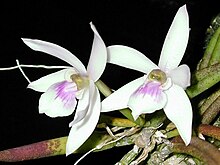Leptotes (orchids)
| Leptotes | ||||||||||||
|---|---|---|---|---|---|---|---|---|---|---|---|---|

Leptotes bicolor |
||||||||||||
| Systematics | ||||||||||||
|
||||||||||||
| Scientific name | ||||||||||||
| Leptotes | ||||||||||||
| Lindl. |
Leptotes is a genus from the family of the orchid (Orchidaceae). The epiphytic growing plants come from South America . The genus was set up in 1833 by John Lindley in " Edwards' Botanical Register ".
description
The Leptotes species are small, herbaceous , perennial plants. Short, cylindrical shoots on the rhizome each have one or rarely two leaves . The leaves are succulent, petal-round and have a longitudinal groove. The roots are surrounded by Velamen radicum , two to four layers of cells thick .
The terminal, racemose inflorescence usually consists of two or three, sometimes up to seven flowers . The petals are white to pink, the lip can also contain yellow parts. The petals are narrower than the sepals . The lip is three-lobed, the side lobes are spread out or turned upwards, but do not envelop the column . The column is widened laterally at the top. The stamen contains six pollinia , four small and a pair of large; the latter are interpreted as an intergrowth of two small ones. The fruit is fleshy and has a vanilla aroma.
distribution
Leptotes is native to the tropical southeast of South America, with most species restricted to Brazil . Leptotes bicolor also occurs in Paraguay , Leptotes unicolor in Argentina .
The species grow epiphytically in various forests, from dry situations on the coast to moist, montane rainforests. Leptotes unicolor also occurs in subtropical coniferous forests with araucarias ( Araucaria ) and stone slices ( Podocarpus ).
Systematics and botanical history
Leptotes was set up in 1833 by John Lindley with the type species Leptotes bicolor . The name comes from the Greek and means "delicate, delicate".
Leptotes is closely related to the genus Loefgrenianthus , furthermore with Constantia , Isabelia and Pseudolaelia .
The information on the number of species varies between 10 valid names and various synonyms :
- Leptotes beatricis A.S. Medeiros, Pegoraro & Xim.Bols. : This species, first described in 2013, occurs in the Brazilian state of Santa Catarina .
- Leptotes bicolor Lindl. (Syn .: Leptotes serrulata Lindl. , Leptotes glaucophylla Hoffmanns. ): It occurs in Brazil and Paraguay.
- Leptotes bohnkiana Campacci : It occurs in Brazil.
- Leptotes harryphillipsii Christenson : It occurs in southeastern Brazil.
- Leptotes mogyensis Krackow. ex Christenson : It occurs in southeastern Brazil.
- Leptotes pauloensis Hoehne : It occurs from the Brazilian state of Espírito Santo to the state of Santa Catarina.
- Leptotes pohlitinocoi V.P. Castro & Chiron : It occurs in the Brazilian state of Bahia.
- Leptotes tenuis Rchb. f. (Syn .: Leptotes minuta Rolfe ): It occurs from the Brazilian state of Espírito Santo to the state of Santa Catarina .
- Leptotes unicolor Barb. Rodr. (Syn .: Leptotes paranaensis Barb. Rodr. ): It occurs from Brazil to Paraguay and northeast Argentina.
- Leptotes vellozicola Van den Berg, ECSmidt & Marçal : It occurs in the Brazilian state of Bahia.
use
Leptotes are occasionally grown as ornamental plants. They are generally very easy to cultivate as tied plants or in small pots when kept at a temperature and temperature. A short rest period after flowering is beneficial for growth, but not absolutely necessary.
supporting documents
Most of the information in this article comes from:
- Alec M. Pridgeon, Phillip Cribb , Mark W. Chase (Eds.): Genera Orchidacearum. Epidendroideae (Part one) . 2nd Edition. tape 4/1 . Oxford University Press, New York and Oxford 2005, ISBN 0-19-850712-7 , pp. 271-274 .
- Carl L. Withner : The Cattleyas and their relatives . Volume III. Schomburgkia, Sophronitis, and Other South American Genera. Timber Press, Portland 1993, ISBN 0-88192-269-2 , pp. 94-98 .
Individual evidence
- ↑ a b c d e f g h i j k Rafaël Govaerts (Ed.): Leptotes. In: World Checklist of Selected Plant Families (WCSP) - The Board of Trustees of the Royal Botanic Gardens, Kew . Retrieved July 13, 2018.





